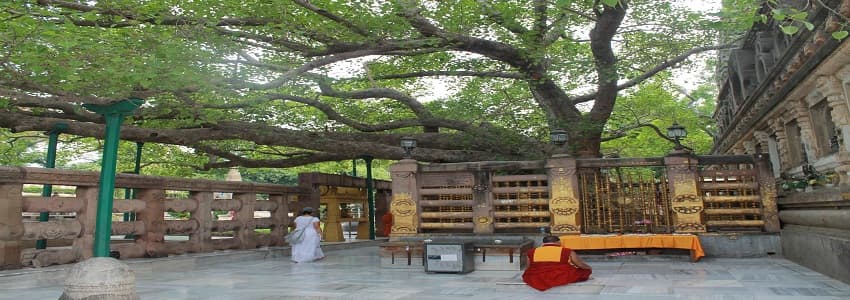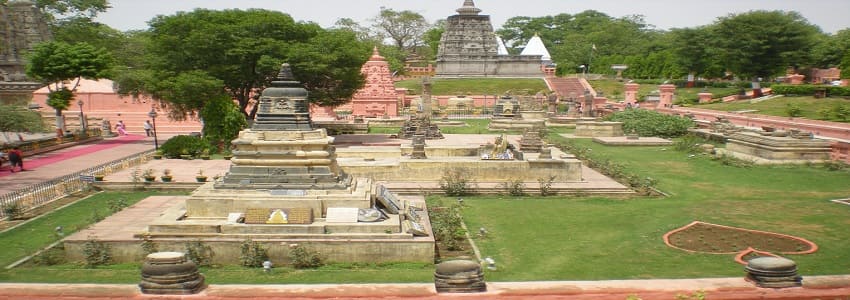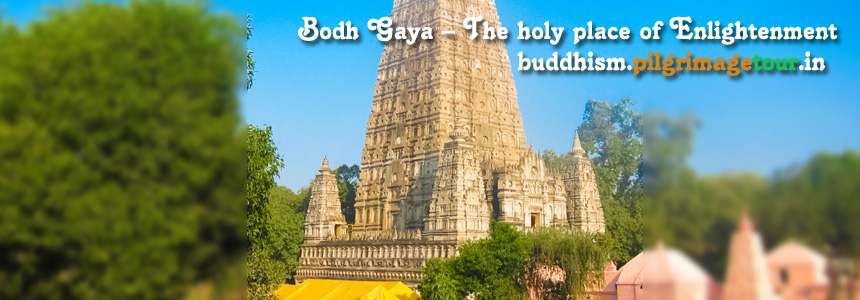The most hallowed of Buddhist pilgrimage destinations, Bodh Gaya is where Gautama Siddhartha saw the culmination of his spiritual journey and metamorphosed into Buddha. The spiritual light he brought in through this transformation lives to this day, showing a way out of human suffering to millions who walk the path of this ‘Middle way’. What is undeniably true of this sacred land is that it harbors the blessedness evocative of this potent transformation to this day. It’s difficult to overlook the spiritually potent vibrations that have become part of the soil, its air, its revered Bodhi tree, the skies and each particle of its dust. No wonder the sacred land is sought out by students, enthusiasts and pilgrims of Buddhism to learn, study, practice and know the beautifully ordained spiritual path better. Just being in its sacred premises immerses one in a meditative realm, making the environment conducive for serious and sincere spiritual practice.
Mahabodhi Temple complex is the chief attraction of Bodh Gaya. The Temple complex surrounded by beautiful gardens is a true delight to one’s senses and offers retreat to the soul. The tranquil gardens still houses the successor of the Bodhi Tree under which Buddha sought and attained enlightenment. The magnificently built Mahabodhi Temple has been listed under UNESCO World Heritage Sites. Its origins date back to 2nd century BCE with Emperor Ashoka erecting a simple shrine, while the present temple was mostly built in 6th century AD. It had undergone many cycles of destructions and subsequent restorations. A 50 m high pyramidal spire tops the ornate structure. The inner shrine of Mahabodhi Temple houses a two m high seated Buddha which is dated back to tenth century AD. Other archeological relics in the temple precincts include four sculpted railings from the Sunga period (184 -72 BC).
The first thing that comes to one’s mind upon hearing the word Bodh Gaya is its Bodhi tree. Legend has it that Siddhartha, disillusioned after years of earnest ascetic practice, sat under a Bodhi tree in what is now Bodh Gaya, resolute in his intention that he wouldn’t budge from his meditative dhyana until he discovers the Truth. After 49 days of continual meditation, he attained enlightenment. The present Bodhi tree inside the temple complex of Bodh Gaya is said to be a direct descendent of that legendary Bodhi Tree.
History of Bodhi Tree in Bodhi Gaya

Emperor Ashoka who came to throne nearly two centuries after the lifetime of Buddha and was committed to spreading of His noble teachings took special care in preserving the ‘Sri Maha Bodhi’ tree. But his wife Tissarakkha caused the tree’s destruction either because of her inclination towards Janinism or due to her jealousy and rage at Ashoka’s spending so much time meditating under its shade. But one of the saplings of the original tree which was sent to Sri Lanka by Sanghamitta had already begun to flourish by then. A cutting of the same was transplanted to the soil where the initial tree was rooted in. That forms the interesting historical trajectory of Bodhi tree that adorns Mahabodhi Temple Complex. Did you know that you can still witness the precise spot of Buddha’s enlightenment for a red sandstone slab placed by Emperor Ashoka marks the same?
Seven spots in Mahabodhi Temple
The holiest of holy Mahabodhi Temple complex is rather huge and contains multitude of attractions inside its sacred precincts. Sri Buddha is said to have spent seven weeks after attainment of enlightenment in the Mahabodhi Temple area reflecting, consolidating and fully embodying the depths of the revelations his soul had opened into. Seven spots inside the Temple mark the seven corresponding seven sites.
- Bodhi Tree – The first week following enlightenment was spent by Sri Buddha under the sacred shade of the tree itself. Located on the western side of Mahabodhi Temple complex, the successor of that tree standing in the same soil evokes awe and utmost devotion in all who beholds it.
- Animeshlocha Stupa – This marks the spot at which Sri Buddha sat staring at the Bodhi Tree, and is known as the unblinking stupa or ‘animeshlocha stupa’. A statue of Buddha staring at the Bodhi tree marks the revered site. This is situated on the northern end of the beautiful temple complex.
- Ratnachakrama (Jewelled Ambulatory) – Stone lotuses raised in the famed ambulatory are meant to emulate true lotus flowers that sprang forth as Buddha paced back and forth between the Bodhi Tree and Animeshlocha stupa in the third week.
- Ratnaghar Chaitya – Buddha spent the fourth week contemplating on the nature of Truth he has received at this spot situated on the northeastern end of the Mahabodhi Temple.
- Ajapala Nigrodh Pillar- A pillar marks the spot at which Sri Buddha spent the fifth week after his enlightenment under the shade of an Ajapala Nigrodh He spent his days in meditation and answering the queries of people who assembled therein.
- Lotus Pond – Sri Buddha spent his sixth week near the Lotus Pond situated on the southern end of the Temple Complex.
- Rajyatana Tree – In the southeastern side of the Mahabodhi Temple Complex, a Rajyatana tree marks the site at which Sri Buddha spent his seventh week in.
Other Attractions in Bodh Gaya

The temple complex houses a unique Meditation Park as well. This is to cater to those whose seek extra solitude. If you begin or end the day with a stroll across the precincts of Mahabodhi Temple Complex, it’s as if you get to witness the undulating waves of maroon and yellow since scores of Buddhist monks perform prayerful prostrations in its compound. Soaking up the spiritual vibrations of the Mahabodhi Temple Complex in Bodh Gaya truly refills one’s soul.
People from nations like Bhutan, Thailand, Sikkim, Taiwan, Tibet, Vietnam, China, Japan, Nepal, Myanmar and Sri Lanka have constructed many Buddhist monasteries and temples around the Mahabodhi Temple. The architecture of these temples reflects the corresponding architectural style of the respective countries.



